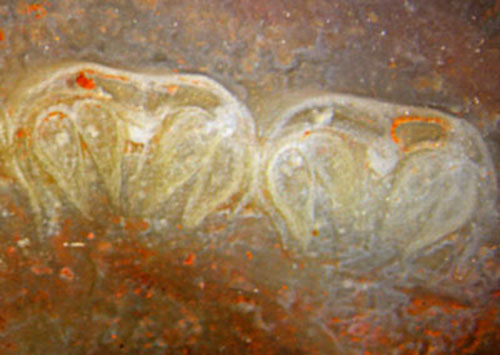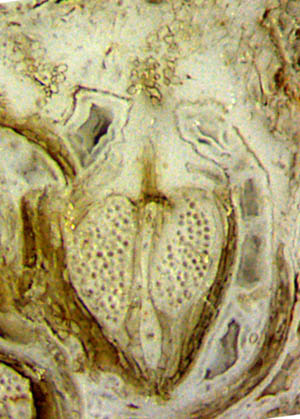"Maggot
stones" reconsidered
Permian cherts
with fern pinnules enclosed, called "maggot stones" when discovered in
the Doehlen basin in 18th century, had
once furthered the progress of palaeobotany in Germany. Therefore,
these fossils have aroused the palaeobotanists' attention up
to recent times. They have got the name Scolecopteris elegans, whose
first part literally means "maggot fern". Problems arise
with more maggot
fern species being discovered worldwide. Repeated attempts to
ascribe all "maggot ferns" found in the Döhlen basin to only one
species, as in [1] and related publications, are highly questionable in
view of the facts presented here.
As expected, longitudinal cuts of
the spore capsules (sporangia) including
the very tip are seldom seen incidentally but provide
the best representation of the shape.
Pointed tips are more likely recognized in
transparent chalcedony, even if they are not exactly in the cut plane
but slightly off, as in Fig.1. As a
peculiar but irrelevant fact, cavities due to the decay of the
tissue are seen here partially lined with hematite.

Fig.1: Scolecopteris
pinnule cross-sections in transparent chalcedony, sporangia cut nearly
lengthwise; Permian chert found at the type location of Sc. elegans. Image
width 4.4mm.
 The sporangia of Permian tree ferns are
fused into groups called synangia. The absence of distinct pedicels
or stalks
on the synangia in Fig.1 suggests, by comparison with drawings in
[2, Figs.3,5], an affiliation with the species Sc. elegans.
(The whitish pads at the synangium bases above right are no stalks.)
The sporangia of Permian tree ferns are
fused into groups called synangia. The absence of distinct pedicels
or stalks
on the synangia in Fig.1 suggests, by comparison with drawings in
[2, Figs.3,5], an affiliation with the species Sc. elegans.
(The whitish pads at the synangium bases above right are no stalks.)
Fig.2 (right): Detail of Permian fern pinnule
cross-section with sporangia borne on a big common pedicel. Found at
the type location of Sc.
elegans
but representing a different species. Image width 1mm.
By a strange twist of notions, the clearly seen
beautifully
preserved pinnules
on the surface of the chert sample where Fig.2 is taken from have
misled the author [3] to the assumption that this sample is suitable
as a type specimen representing the original maggot fern Sc. elegans.
With this assumption, the author [3] obviously did not expect big
pedicels, did not specially look for them, and hence
did not notice them [3,Fig.210A-G].
Own observations [4] on this sample suggest that the
pinnules offered in [3] as Sc.
elegans probably belong to
Sturiella intermedia
[5], also known as Scolecopteris intermedia
[7]. So it appears that one of the very chert samples meant to support
the notion of only one maggot fern species in
the Doehlen basin [3] provides opposite evidence. This is not quite
unexpected in view of pinnule sections seen before [2, Figs.6-8]
and
pictured unawares even earlier in [6] where a sample found by Etzold
about 1890 is shown. Contrary to good scientific practice, deviating
features
had been ignored in [1,3,6], possibly with the intent to make believe
that the
maggot fern specimens from Doehlen basin "can doubtless be assigned
to Sc. elegans"
[3, p.226], which has turned out erroneous.
The attempt to provide an updated description of
the debated fossil
Scolecopteris elegans
based
on three selected chert samples [3], one of them ill-chosen (Fig.2), is
of no value and causes confusion. In this case, confusion is not only
due to different species but also to erroneous size data.
There are so many of them in [3] that all are useless since one does
not know which ones may be valid.
The author M.
Barthel
and the Editor-in-Chief of Geologica Saxonica, J.-M. Lange,
ignored early warnings and refused corrections of the erroneous size
data under the absurd
pretense that they all were within the limits of natural variation,
which is obviously not true.
Hence, this brief contribution does not only
concern disputed fossils but also
serves as a warning against irresponsible palaeobotanists who stick to
their errors
depite contrary evidence from old writings and new finds.
Samples
collected during earthworks at the classical "maggot
stone" site: Kohlenstrasse at the boundary between Kleinnaundorf and
Burgk, districts of Freital, Doehlen basin.
Bu7/89.3, found in 2000; Bu8/18, found by Ulrich Wagner,
Dresden, in 1997, among excavated soil at Freital-Burgk, Am
Seilerschuppen.
H.-J.
Weiss 2021
[1] M.
Barthel:
The maggot stones from Windberg ridge.
in: U. Dernbach,
W.D. Tidwell: Secrets of
Petrified Plants, D'ORO Publ., 2002. p. 65-77.
[2] H.-J.
Weiss:
Scolecopteris
synangium stalks
– illusory and real ones.
chertnews.de, Permian Chert News 4, (2011) .
[3]
M. Barthel:
Die Rotliegendflora der Döhlen-Formation. Geologica Saxonica 61 (2)
(2015, released in 2016), 105-238.
[4] H.-J. Weiss: Maggot
fern confusion. chertnews.de, Permian
Chert News 26, (2019).
[5] M.A. Millay:
A review of permineralized Euramerican Carboniferous tree
ferns. Rev. Pal. Pal. 95(1997), 191-209.
[6] M. Barthel:
Pecopteris-Arten E.F. v. Schlotheims aus Typuslokalitäten in der DDR,
Schriftenreihe geol. Wiss. Berlin 16(1980), 275-304.
[7] A. Lesnikowska,
J. Galtier: A reconsideration of four genera of
permineralized Marattiales ... Rev. Pal. Pal. 67(1991), 141-152.
|
 |
 34 34 |

 34
34
 The sporangia of Permian tree ferns are
fused into groups called synangia. The absence of distinct pedicels
or stalks
on the synangia in Fig.1 suggests, by comparison with drawings in
[2, Figs.3,5], an affiliation with the species Sc. elegans.
(The whitish pads at the synangium bases above right are no stalks.)
The sporangia of Permian tree ferns are
fused into groups called synangia. The absence of distinct pedicels
or stalks
on the synangia in Fig.1 suggests, by comparison with drawings in
[2, Figs.3,5], an affiliation with the species Sc. elegans.
(The whitish pads at the synangium bases above right are no stalks.) 
 34
34